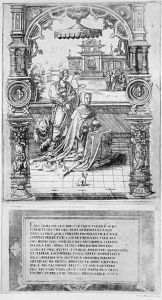Nicholas Hogenberg Paintings
Nicholas Hogenberg, born around the year 1500, was a prominent figure in the world of Renaissance printmaking, particularly known for his works in engraving and etching. His life and career were primarily centered in the vibrant cultural landscapes of the Low Countries and Germany, regions that were significant hubs for the arts during the Renaissance period. Hogenberg's contributions to art are mostly remembered for their intricate detailing, historical significance, and the innovative techniques he employed in the realm of printmaking.
Hogenberg's early life remains somewhat obscure, with few records detailing his upbringing or initial forays into the world of art. However, it is known that he became active as an artist in the first half of the 16th century, a time when the Renaissance was reaching its peak in Northern Europe. The period was characterized by a flourishing of arts and sciences, with printmaking emerging as a crucial medium for the dissemination of ideas, knowledge, and artistic expression.
Throughout his career, Nicholas Hogenberg was involved in producing a wide array of works, including portraits, religious subjects, and scenes depicting historical events. One of his most notable contributions was to the production of the Triumphs of Maximilian I, a monumental series of woodcuts celebrating the life and achievements of the Holy Roman Emperor Maximilian I. This project was a collaborative effort involving several artists and is considered one of the masterpieces of Renaissance printmaking. Hogenberg's role in this undertaking highlights his skill and the esteem in which he was held by his contemporaries.
Despite the significance of his work, many details of Hogenberg's life, including his training and personal life, remain shrouded in mystery. Records suggest that he spent significant parts of his career in cities such as Mechelen and Cologne, which were important centers for the arts during the Renaissance. His movement between these cities reflects the itinerant nature of many artists of the time, who traveled extensively in search of patronage and opportunities to ply their trade.
Nicholas Hogenberg's death in 1539 marked the end of a career that had spanned several decades and had seen the artist make lasting contributions to the field of printmaking. Although not as widely recognized today as some of his contemporaries, Hogenberg's work remains an important part of the study of Renaissance art, offering insights into the techniques, themes, and cultural contexts of the period. His legacy is preserved in the collections of museums and galleries around the world, where his prints continue to be admired for their beauty, craftsmanship, and historical value.
